
The Classic Head $2.50 gold coin is an American coin, also called a quarter eagle, minted from 1834-1839. [1] It features Liberty on the obverse and an eagle on the reverse.

The Classic Head $2.50 gold coin is an American coin, also called a quarter eagle, minted from 1834-1839. [1] It features Liberty on the obverse and an eagle on the reverse.
1834 witnessed tough economic times in the United States. President Andrew Jackson was opposed to the developing central bank of that era known as the Second Bank of the United States. His aim was to reform a system which took power away from the states and concentrated it in the hands of a few. He recognized the potential for abuse and manipulation that was not necessarily in the best interests of the United States. His attacks on the fledgling central bank served to erode their power despite the fact that their charter did not expire until 1836. This allowed the president to introduce banking reform which was officially passed by Congress in 1836. It was known as the Deposit Act. [2]
In 1834, President Jackson began action to strengthen the U.S. economy. His goal was to retire the notes of the Bank of the United States prevalent in society at that time and to replace them with specie gold. In addition, he realized that the ratio between gold and silver must be adjusted if gold specie was to remain in circulation. At that time, the gold to silver ratio was 15:1 while in Europe, the ratio was 15.5:1. This led to the practice of melting down contemporary U.S. gold coins for profit because there was a slightly higher gold content than the face value. This practice led to significant coin rarities in the Capped Bust series of gold coins minted from 1808-1834. [3] Gold specie fineness was reduced from .9167 fine to .8992 fine and the gold to silver ratio was increased to 16:1. This action was extremely astute and ensured that the new $2.50 and $5 coins would remain in circulation. These were the first widely circulated gold coins in US history.
The new quarter eagle also saw a reduction in diameter from 20 millimeters to 18.2 millimeters and a reduction in weight from 4.37 grams to 4.18 grams. This new issue was designed by William Kneass and minted in Philadelphia only. [4]
The original 1834 dated Classic Head $2.50 gold coins come in two different varieties: the "Small Head” and the “Booby Head.” [5]
About uncirculated (AU) and mint state specimens may exhibit proof-like or semi proof-like surfaces. In general, a semi proof-like surface is somewhat reflective around the devices and the edge of the coin as well as around the portrait. Coins that have not been cleaned generally show an original patina manifested with various golden, orange colors and a thick "skin". Advanced collectors seek such specimens as opposed to cleaned, shiny examples. [6]
This series is highly collectible and are relatively inexpensive for an early gold U.S. coin. The astute collector/investor will seek original, problem-free examples and avoid damaged and inferior coins, regardless of the grade. It is also wise to pursue coins authenticated and graded by a leading third party grading service such as Numismatic Guaranty Corporation (NGC) or Professional Coin Grading Service (PCGS).
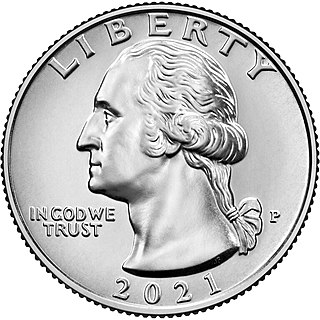
The quarter, short for quarter dollar, is a United States coin worth 25 cents, one-quarter of a dollar. It has a diameter of 0.955 inch (24.26 mm) and a thickness of 0.069 inch (1.75 mm). The coin sports the profile of George Washington on its obverse, and its reverse design has changed frequently. It has been produced on and off since 1796 and consistently since 1831.

The half sovereign is an English and later, British gold coin with a nominal value of half a pound sterling, or ten shillings. It is half the weight of its counterpart 'full' sovereign coin.

The United States Mint is a bureau of the Department of the Treasury responsible for producing coinage for the United States to conduct its trade and commerce, as well as controlling the movement of bullion. It does not produce paper money; that responsibility belongs to the Bureau of Engraving and Printing. The first United States Mint was created in Philadelphia in 1792, and soon joined by other centers, whose coins were identified by their own mint marks. There are currently four active coin-producing mints: Philadelphia, Denver, San Francisco, and West Point.

The dime, in United States usage, is a ten-cent coin, one tenth of a United States dollar, labeled formally as "one dime". The denomination was first authorized by the Coinage Act of 1792. The dime is the smallest in diameter and is the thinnest of all U.S. coins currently minted for circulation, being 0.705 inches in diameter and 0.053 in (1.35 mm) in thickness. The obverse of the current dime depicts the profile of President Franklin D. Roosevelt and the reverse boasts an olive branch, a torch, and an oak branch, from left to right respectively. As of 2011, the dime coin cost 5.65 cents to produce.
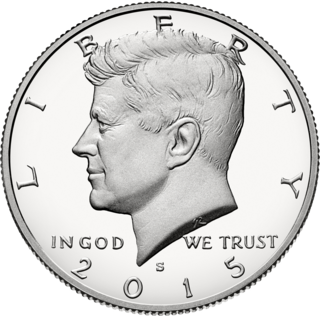
The half dollar, sometimes referred to as the half for short or 50-cent piece, is a United States coin worth 50 cents, or one half of a dollar. It is the largest United States circulating coin currently produced in both size and weight, being 1.205 inches in diameter and 0.085 in (2.16 mm) in thickness, and is twice the weight of the quarter. The coin's design has undergone a number of changes throughout its history. Since 1964, the half dollar depicts the profile of President John F. Kennedy on the obverse and the Seal of the President of the United States on the reverse.
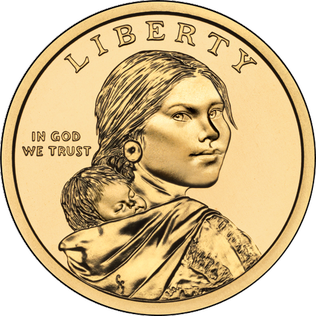
The dollar coin is a United States coin with a face value of one United States dollar. It is the second largest U.S. coin currently minted for circulation in terms of physical size, with a diameter of 1.043 inches and a thickness of 0.079 in (2.0 mm), coming second to the half dollar. Dollar coins have been minted in the United States in gold, silver, and base metal versions. Dollar coins were first minted in the United States in 1794. While true gold dollars are no longer minted, the Sacagawea, Presidential, and American Innovation dollars are sometimes referred to as golden dollars because of their color.

The eagle was a United States $10 gold coin issued by the United States Mint from 1792 to 1933.

The Coinage Act, passed by the United States Congress on April 2, 1792, created the United States dollar as the country's standard unit of money, established the United States Mint, and regulated the coinage of the United States. This act established the silver dollar as the unit of money in the United States, declared it to be lawful tender, and created a decimal system for U.S. currency.

The American Gold Eagle is an official gold bullion coin of the United States. Authorized under the Gold Bullion Coin Act of 1985, it was first released by the United States Mint in 1986. Because the term "eagle" also is the official United States designation for pre-1933 ten dollars gold coins, the weight of the bullion coin is typically used when describing American Gold Eagles to avoid confusion. This is particularly true with the 1/4-oz American Gold Eagle, which has a marked face value of ten dollars.
This glossary of numismatics is a list of definitions of terms and concepts relevant to numismatics and coin collecting, as well as sub-fields and related disciplines, with concise explanations for the beginner or professional.

The Reichsthaler, or more specifically the Reichsthaler specie, was a standard thaler silver coin introduced by the Holy Roman Empire in 1566 for use in all German states, minted in various versions for the next 300 years, and containing 25-26 grams fine silver.

The quarter eagle was a gold coin issued by the United States with a denomination of two hundred and fifty cents, or two dollars and fifty cents. It was given its name in the Coinage Act of 1792, as a derivation from the US ten-dollar eagle coin. Its purchasing power in 1800 would be equivalent to $71.12 in 2015 dollars.

The three-dollar piece was a gold coin produced by the United States Bureau of the Mint from 1854 to 1889. Authorized by the Act of February 21, 1853, the coin was designed by Mint Chief Engraver James B. Longacre. The obverse bears a representation of Lady Liberty wearing a headdress of a Native American princess and the reverse a wreath of corn, wheat, cotton, and tobacco.
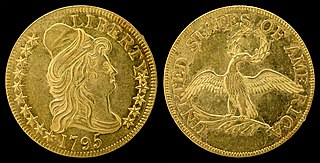
The half eagle is a United States coin that was produced for circulation from 1795 to 1929 and in commemorative and bullion coins since the 1980s. Composed almost entirely of gold, it has a face value of five dollars. Its production was authorized by The Act of April 2, 1792, and it was the first gold coin minted by the United States.

The gold dollar or gold one-dollar piece is a gold coin that was struck as a regular issue by the United States Bureau of the Mint from 1849 to 1889. The coin had three types over its lifetime, all designed by Mint Chief Engraver James B. Longacre. The Type 1 issue has the smallest diameter of any United States coin minted to date.
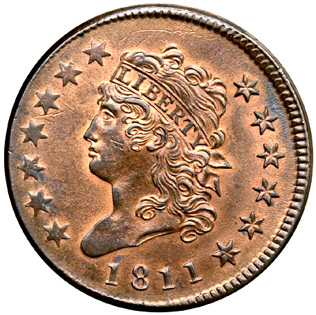
The Classic Head was a coin design issued by the United States Mint in the early 19th century. It was introduced for copper coinage in 1808 by engraver John Reich and later redesigned and improved by Chief Engraver William Kneass.
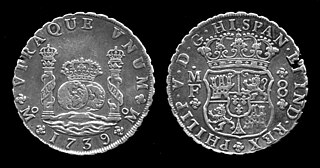
The numismatic history of the United States began with Colonial coins such as the pine tree shilling and paper money; most notably the foreign but widely accepted Spanish piece of eight, ultimately descended from the Joachimsthaler and the direct ancestor of the U.S. Dollar.
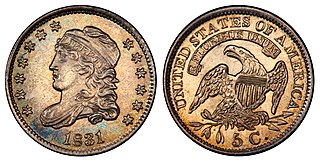
The Capped Bust coinage of the United States consisted of a half dime, dime, quarter and half dollar.

The 1804 dollar or Bowed Liberty Dollar was a dollar coin struck by the Mint of the United States, of which fifteen specimens are currently known to exist. Though dated 1804, none were struck in that year; all were minted in the 1830s or later. They were first created for use in special proof coin sets used as diplomatic gifts during Edmund Roberts' trips to Siam and Muscat.

The Union was a proposed $100 coin of the United States dollar. It was canceled before any pattern coins could be minted.